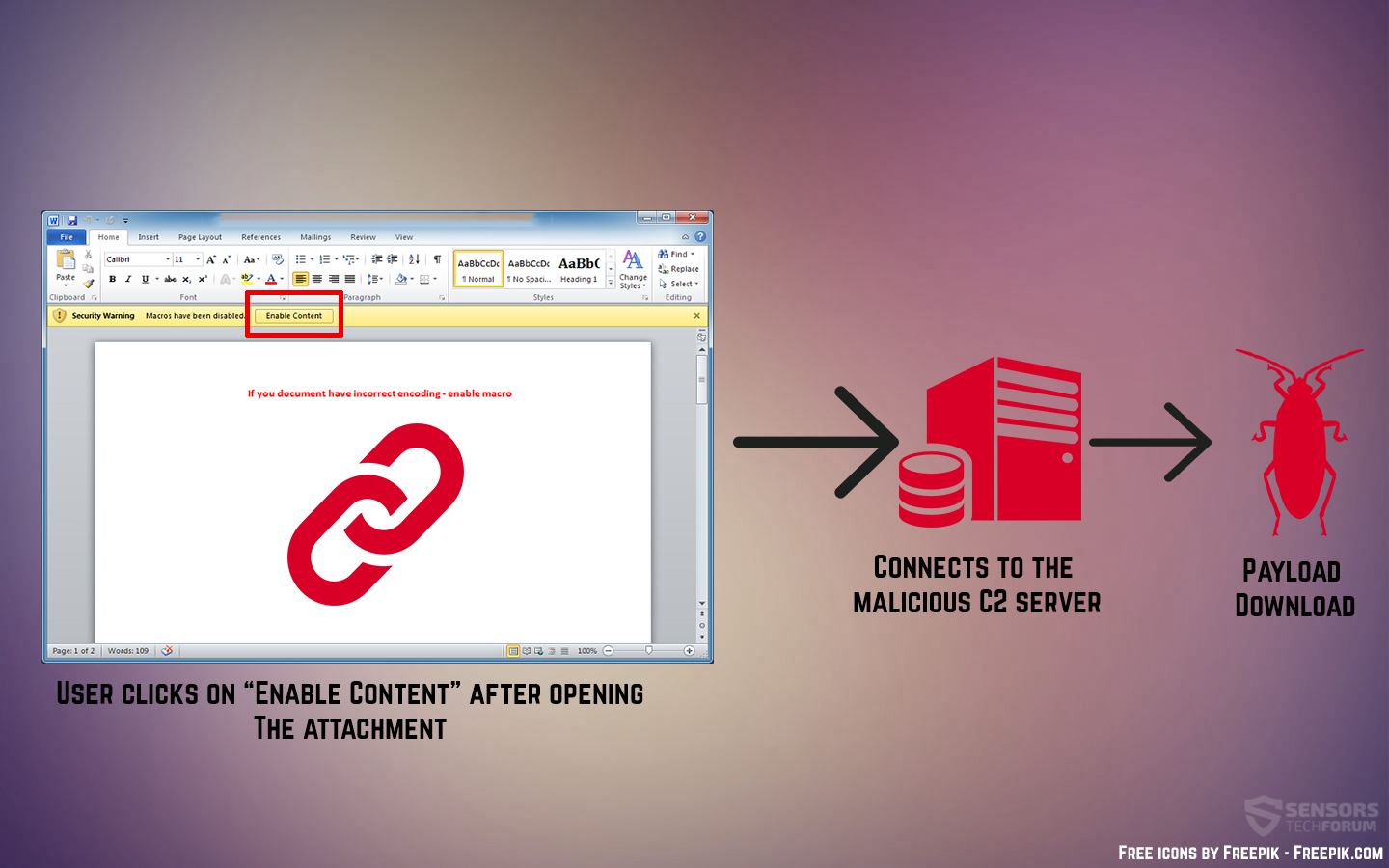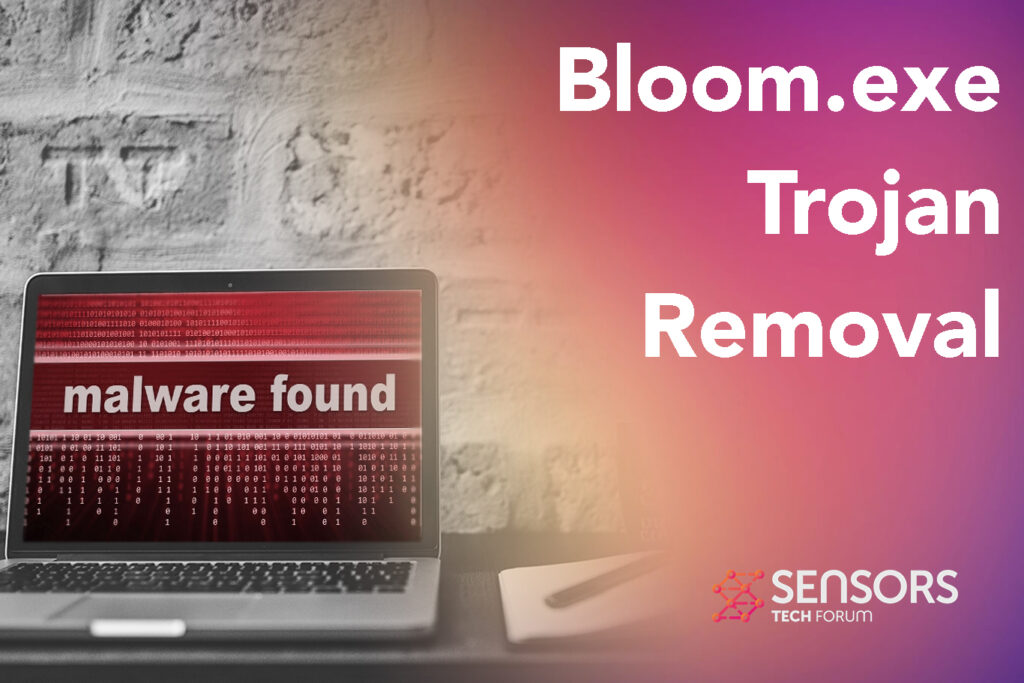What Is Bloom.exe
Bloom.exe is the name of an executable, that has been reported to be related to multiple kinds of viruses, the main ones of which is an alleged Trojan horse. These malware strains are very dangerous and they may perform a lot of different malicious activities while silently lurking around in your computer without your consent and knowledge. Such viruses can be very problematic as they can bring more malware and they can even damage your files and your computer system permanently, which is why they are categorised as high-level threats.
Read this article in order to understand how to detect and remove Bloom.exe from your computer system and clean it up completely.
Bloom.exe Summary
| Name | Bloom.exe |
| Type | Trojan Horse |
| Short Description | Aims to infect your computer and steal files or cause harm to your operating system. |
| Symptoms | The trojan may run fake processes in Windows Task Manager.. |
| Distribution Method | Via e-mail or fake sites. |
| Detection Tool |
See If Your Device Has Been Affected by Bloom.exe
Download
Malware Removal Tool
|
User Experience | Join Our Forum to Discuss Bloom.exe. |
Bloom.exe Virus – Why Do I See It?
Bloom.exe is mainly detected by antivirus apps as a Trojan horse. Other viruses similar to it include Vigorf or Ground.exe. You may see it showing up because of falling trap to a nasty malware infection without your knowledge or consent.
Bloom.exe Trojan – How Did I Get It
Typically, the main ways these applications use to get inside your computer undetected by pretending to be a legitimate file that is sent to you via email in the form of an attachment or a file linked in an external download URL. If this is the case, then it is very open these files tend to mimic legitimate documents, for example the following:
- Flight or train tickets invoices.
- Documents that are important for you.
- Receipts for orders.
- Invoices for purchases you do not remember making.
Most of the documents in this case could pretend to be legitimate, but in reality they carry malicious macro code in them, that may trigger the following infection process:

Another very often used way via which these applications and up infecting your computer is to pretend to be some sort of a download executables that are posted on low-reputation websites while waiting to be downloaded by victims, for example:
- Key generators or keygens.
- Software activation files.
- Patches for games or software.
- Cracks for software.
Bloom.exe Trojan – What Does It Do?
It is very dangerous. Once it infects your computer system, this Trojan horse may activate its payload files, including the .exe, which may perform a lot of different activities after they assume administrator access over your computer system. These fires me off of the locate it in the system directories of Windows, like the following:
- %Windows%
- %System%
- %System32%
- %Local%
- %AppData%
- %Temp%
- %LocalLow%
- %Roaming%
These files will allow the Trojan to update itself, remain hidden and possibly install even more malware on your computer. The main idea of such viruses is usually to spy on what you do and get critical information about your financial and personal details that you may keep and also photos, videos and other sensitive information about you.
Bloom.exe Virus – Is It Malware?
Yes. Since Bloom.exe has been reported to be a Trojanized application, it may perform all kinds of virus activities, based on the configuration it has been through by the cyber-criminals behind it. Some of the malicious activities likely performed by this trojan may include the following:
- Damage your OS.
- Steal your files.
- Record audio and video from your microphone and camera.
- Delete files.
- Install other malware on your comptuer.
- Update itself to stay hidden for longer periods of time.
This is the main reason why this virus is classified as a high level threat and should be gotten rid of immediately.
Bloom.exe Virus – Is It Dangerous?
Usually, these Trojan horses are operated by servers somewhere, held by the cyber criminal entities that are behind them and they are the ones in control with what can happen to this virus on your computer. If they decide, they can even configured the virus to download a component without you even realising it and this component can break your Operating System completely.
What to Do If I See This Virus?
If you see Bloom.exe virus on your computer, the best thing to do is disconnect your device from the internet, run a full scan with an anti-malware program, and delete or quarantine any infected files. If the virus is severe and your computer is still not functioning properly, you may need to restore your system to factory settings. It’s also important to update your operating system and any installed programs to ensure your computer is protected from the latest security threats. Additionally, you should avoid clicking on suspicious emails, links, and websites to prevent future virus infections.

Remove Bloom.exe Trojan from Your Device
Just like any other Trojan, Bloom.exe can also be removed by deleting its core system files. The removal instructions below have been designed specifically to help you do that by yourself or automatically. If you do not have experience in malware removal, it is strongly advisable to take the automatic approach and run a scan of your computer, using a professional anti-malware software. Such a program has been specifically created in order to detect where the malware is located and remove it completely, while ensuring future protection as well.
Preparation before removing Bloom.exe.
Before starting the actual removal process, we recommend that you do the following preparation steps.
- Make sure you have these instructions always open and in front of your eyes.
- Do a backup of all of your files, even if they could be damaged. You should back up your data with a cloud backup solution and insure your files against any type of loss, even from the most severe threats.
- Be patient as this could take a while.
- Scan for Malware
- Fix Registries
- Remove Virus Files
Step 1: Scan for Bloom.exe with SpyHunter Anti-Malware Tool



Step 2: Clean any registries, created by Bloom.exe on your computer.
The usually targeted registries of Windows machines are the following:
- HKEY_LOCAL_MACHINE\Software\Microsoft\Windows\CurrentVersion\Run
- HKEY_CURRENT_USER\Software\Microsoft\Windows\CurrentVersion\Run
- HKEY_LOCAL_MACHINE\Software\Microsoft\Windows\CurrentVersion\RunOnce
- HKEY_CURRENT_USER\Software\Microsoft\Windows\CurrentVersion\RunOnce
You can access them by opening the Windows registry editor and deleting any values, created by Bloom.exe there. This can happen by following the steps underneath:


 Tip: To find a virus-created value, you can right-click on it and click "Modify" to see which file it is set to run. If this is the virus file location, remove the value.
Tip: To find a virus-created value, you can right-click on it and click "Modify" to see which file it is set to run. If this is the virus file location, remove the value.Step 3: Find virus files created by Bloom.exe on your PC.
1.For Windows 8, 8.1 and 10.
For Newer Windows Operating Systems
1: On your keyboard press + R and write explorer.exe in the Run text box and then click on the Ok button.

2: Click on your PC from the quick access bar. This is usually an icon with a monitor and its name is either “My Computer”, “My PC” or “This PC” or whatever you have named it.

3: Navigate to the search box in the top-right of your PC's screen and type “fileextension:” and after which type the file extension. If you are looking for malicious executables, an example may be "fileextension:exe". After doing that, leave a space and type the file name you believe the malware has created. Here is how it may appear if your file has been found:

N.B. We recommend to wait for the green loading bar in the navigation box to fill up in case the PC is looking for the file and hasn't found it yet.
2.For Windows XP, Vista, and 7.
For Older Windows Operating Systems
In older Windows OS's the conventional approach should be the effective one:
1: Click on the Start Menu icon (usually on your bottom-left) and then choose the Search preference.

2: After the search window appears, choose More Advanced Options from the search assistant box. Another way is by clicking on All Files and Folders.

3: After that type the name of the file you are looking for and click on the Search button. This might take some time after which results will appear. If you have found the malicious file, you may copy or open its location by right-clicking on it.
Now you should be able to discover any file on Windows as long as it is on your hard drive and is not concealed via special software.
Bloom.exe FAQ
What Does Bloom.exe Trojan Do?
The Bloom.exe Trojan is a malicious computer program designed to disrupt, damage, or gain unauthorized access to a computer system. It can be used to steal sensitive data, gain control over a system, or launch other malicious activities.
Can Trojans Steal Passwords?
Yes, Trojans, like Bloom.exe, can steal passwords. These malicious programs are designed to gain access to a user's computer, spy on victims and steal sensitive information such as banking details and passwords.
Can Bloom.exe Trojan Hide Itself?
Yes, it can. A Trojan can use various techniques to mask itself, including rootkits, encryption, and obfuscation, to hide from security scanners and evade detection.
Can a Trojan be Removed by Factory Reset?
Yes, a Trojan can be removed by factory resetting your device. This is because it will restore the device to its original state, eliminating any malicious software that may have been installed. Bear in mind that there are more sophisticated Trojans that leave backdoors and reinfect even after a factory reset.
Can Bloom.exe Trojan Infect WiFi?
Yes, it is possible for a Trojan to infect WiFi networks. When a user connects to the infected network, the Trojan can spread to other connected devices and can access sensitive information on the network.
Can Trojans Be Deleted?
Yes, Trojans can be deleted. This is typically done by running a powerful anti-virus or anti-malware program that is designed to detect and remove malicious files. In some cases, manual deletion of the Trojan may also be necessary.
Can Trojans Steal Files?
Yes, Trojans can steal files if they are installed on a computer. This is done by allowing the malware author or user to gain access to the computer and then steal the files stored on it.
Which Anti-Malware Can Remove Trojans?
Anti-malware programs such as SpyHunter are capable of scanning for and removing Trojans from your computer. It is important to keep your anti-malware up to date and regularly scan your system for any malicious software.
Can Trojans Infect USB?
Yes, Trojans can infect USB devices. USB Trojans typically spread through malicious files downloaded from the internet or shared via email, allowing the hacker to gain access to a user's confidential data.
About the Bloom.exe Research
The content we publish on SensorsTechForum.com, this Bloom.exe how-to removal guide included, is the outcome of extensive research, hard work and our team’s devotion to help you remove the specific trojan problem.
How did we conduct the research on Bloom.exe?
Please note that our research is based on an independent investigation. We are in contact with independent security researchers, thanks to which we receive daily updates on the latest malware definitions, including the various types of trojans (backdoor, downloader, infostealer, ransom, etc.)
Furthermore, the research behind the Bloom.exe threat is backed with VirusTotal.
To better understand the threat posed by trojans, please refer to the following articles which provide knowledgeable details.



